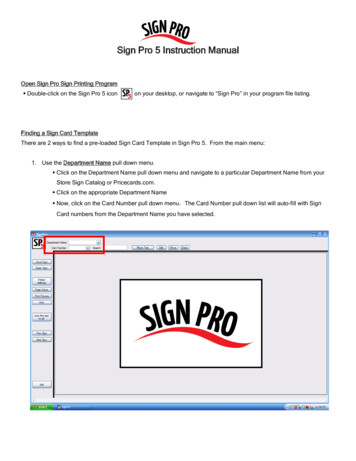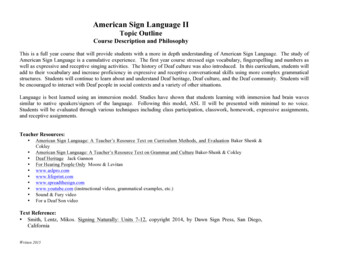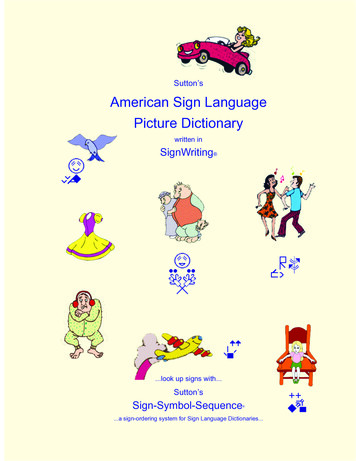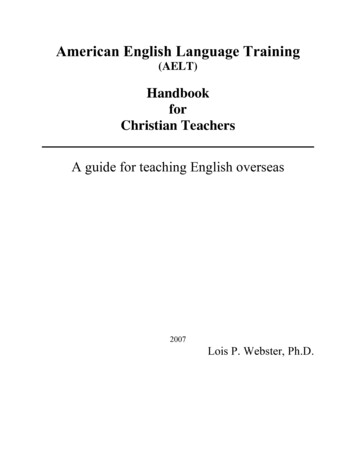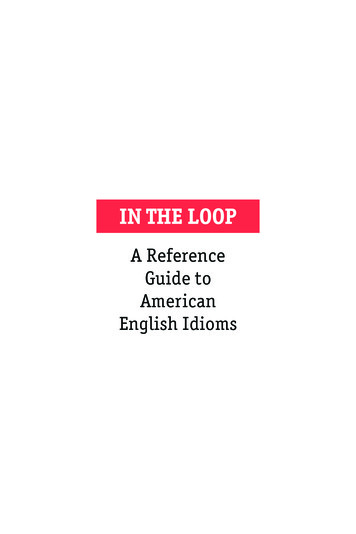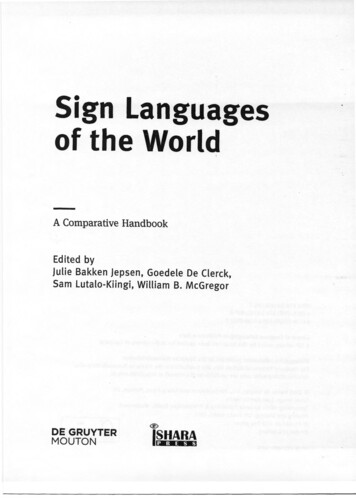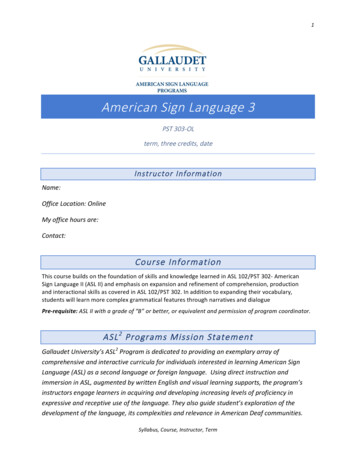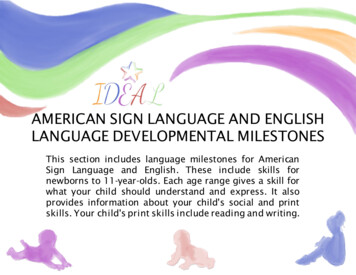
Transcription
AMERICAN SIGN LANGUAGE AND ENGLISHLANGUAGE DEVELOPMENTAL MILESTONESThis section includes language milestones for AmericanSign Language and English. These include skills fornewborns to 11-year-olds. Each age range gives a skill forwhat your child should understand and express. It alsoprovides information about your child's social and printskills. Your child's print skills include reading and writing.
Table of ContentsIntroductionM-336-42 mos. receptive and expressive language skillsM-220-3 mos. receptive and expressive language skillsM-436-42 months social and print skillsM-230-3 months social and print skillsM-542-48 mos. receptive and expressive language skillsM-243-6 mos. receptive and expressive language skillsM-642-48 months social and print skillsM-253-6 months social and print skillsM-74-5 yrs. receptive and expressive language skillsM-266-9 mos. receptive and expressive language skillsM-84-5 years social and print skillsM-276-9 months social and print skillsM-95-6 yrs. receptive and expressive language skillsM-289-12 mos. receptive and expressive language skillsM-105-6 years social and print skillsM-299-12 months social and print skillsM-116-7 yrs. receptive and expressive language skillsM-3012-15 mos. receptive and expressive language skillsM-126-7 years social and print skillsM-3112-15 months social and print skillsM-137-8 yrs. receptive and expressive language skillsM-3215-18 mos. receptive and expressive language skillsM-147-8 years social and print skillsM-3315-18 months social and print skillsM-158-9 yrs. receptive and expressive language skillsM-3418-24 mos. receptive and expressive language skillsM-168-9 years social and print skillsM-3518-24 months social and print skillsM-179- 10 yrs. receptive and expressive language skillsM-3624-30 mos. receptive and expressive language skillsM-189-10 years social and print skillsM-3724-30 months social and print skillsM-1910-11 yrs. receptive and expressive language skillsM-3830-36 mos. receptive and expressive language skillsM-2010-11 years social and print skillsM-3930-36 months social and print skillsM-21ReferencesM-40M-2
Developmental milestones are the behaviors or skills seen in infants and children as they grow,learn, and change. There is a typical range in which a child will reach a milestone. Milestones onmost checklists are not when an average child has mastered a skill. It is when 80-90% of thechildren within that age range have mastered the listed skills. Keeping track of milestones can helpidentify when your child may need some support (e.g., language therapy). The sooner your childreceives any needed supports, the better their outcomes will be.This resource includes milestones forspokenEnglishfromStandardAmerican English. It does not addresspossible grammar differences that arepresent because of dialects. Dialectsare rule-based variations of English.Your c hild should look/sound like theircommunity. This community willinclude family, neighborhood friends,and school friends. Standard AmericanEnglish is used for reading and writingin Indiana schools.In this resource, you will seeexamples of American SignLanguage (ASL) provided in printusing gloss. ASL does not havea print form. It is also notderived from English. To giveexamples of a skill, gloss is usedto represent the signs word forword. The gloss does not showthe meaning. ASL gloss ispresented in capital letters anduses sy mbols to show somegrammar.As your child’s first teacher, you have an amazing opportunity to nurture your c hild’slanguage growth. By taking an active role, parents can help ensure that their childhas all the support they need to develop to their full potential.M-3
0-3 Months Receptive and Expressive Language SkillsLanguage your child understandsYour child will respond to your face and lookattentively at your face (by 3 months).How your child expressesthoughts/feelingsYour child will cry to express hunger and/oranger.Your child will begin to gurgle, laugh, and smile.Your child will bring both hands to their mouth.0-3 MonthsYour child will express basic feelings and needs.ASLSpoken EnglishASLSpoken EnglishYour child will look in thedirection the signer ispointing.Your child will begin tosearch for the source ofa sound.Your child will begin toplay by holding handsand fingers.Your child will begin tovocalize to expresspleasure.Your child will begin tofocus on faces andhands.Your child will respondto talking by quieting orsmiling.Your child willYour child will begin tosometimes vocalize insmile to express pleasure.response to sounds.Your child will begin tolook at the visualenvironment withalertness.Your child will reactdifferently to voices,sounds, and emotions.Your child will sometimeslook in the direction ofmovements.Your child will startle tosudden noises.Your child will begin toexpress interest inmovement.Your child will quiet to afamiliar voice.M-4
0-3 Months Social and Print SkillsYour Child’s Social and Play SkillsYour Child’s Print SkillsYour child will begin to smile and respond to you.Your child will look at your face and localize you with theireyes (by 3 months).Your child will smile in response to your signing/talking.Your c hild will give a true social smile and/or coo in responseto a familiar face.Your child will begin to imitate facial movements.Early exposureto books isimportant! Tryusing tummytime to readsimple boardbooks to yourchild. JDHKYou have begun the exciting journey of watching yourchild grow, learn, and change! We hope you cherishthe time you have to focus on loving and bonding withyour baby who is deaf or hard of hearing. M-5
3-6 Months Receptive and Expressive Language SkillsLanguage your child understandsHow your child expressesthoughts/feelingsYour child will discriminate between angry andfriendly tones and facial expressions; cry inresponse to an angry voice/expression.Your child will blow raspberries, coo, yell.Your child will use non-verbal means to callattention to physical needs (e.g., toileting,hunger).3-6 MonthsYour child will use non-verbal means to expresspersonal reactions (e.g., curiosity, surprise,reluctance).Your child will begin to express excitement anddispleasure.ASLSpoken EnglishASLSpoken EnglishYour child will follow theeye gaze and movementof the signer.Your child will localize asound source with ahead or eye turn.Your child will copymovements involving thearms, hands, head, andface.Your child will voicedifferent sounds toexpress varied emotions(e.g., social intent,protest).Your child will attend tosign presented with slow,repeated, largemovements.Your child willsometimes respond totheir own name.Your child willhand/finger babble (e.g.,open and close hands,wiggle fingers, twistwrists).Your child will babblewith a variety of sounds,vowels, and consonants. JDHKYour child will oftenstop crying in responseto voice.Your child will try toimitate sounds.Your child will vocalizewhen you talk to them.Your child will vocalizefor needs and wants, inresponse to others, andwhen alone.M-6
3-6 Months Social and Print SkillsYour Child’s Social and Play SkillsYour Child’s Print SkillsYour child will engage in play (e.g., peek-a-boo).Your child will begin to enjoy finger-plays/finger games.Your child will imitate facial expressions.Your child will have joint attention (e.g., look at an objectwith you).Your child will maintain eye contact.Sign/Talk to your babythroughout the day. Tellthem about your plans,show them something ina store window, and askthem questions. Yourbaby will learn and laterrespond to you. JDHKM-7
6-9 Months Receptive and Expressive Language Skills6-9 MonthsLanguage your child understandsHow your child expressesthoughts/feelingsYour child will look at a toy you show them.Your child will show objects by holding,pointing, reaching, or looking at them.Your child will look attentively at a person’sface.Your child will use some gestures (e.g., shakeshead for no).Your child will begin to show attention tostorytelling/story-signing.Your child will smile, make eye contact, andlaugh.Your child will respond with gestures to words(e.g., up, hi , bye-bye) .Your child will show they are excited or upset.Your child will use language to note thedisappearance of objects (e.g., all gone).ASLASLSpoken EnglishYour child will alertlytrack/follow the eyegaze of a signer.Your child will sometimesYour child willrespond to family names,hand/finger babble.“no,” and own name.Your child willunderstand emotionsshown on your face(e.g., anger,friendliness).Your child will enjoymusic or singing.Spoken EnglishYour child will appear to“sing”. JDHKYour child will laughwhen sees fingersapproach to tickle.Your child will repeatconsonant-vowelsyllables (e.g., pa pa).Your child will appear tolisten to the wholeconversation betweenothers.M-8
6-9 Months Social and Print SkillsYour Child’s Social and Play SkillsYour Child’s Print SkillsYour child will use gesture and/or voice to initiate contact.Your child will attend to/vocalize and pat pictures.Your child will understand communication turn-taking.Your child will begin to share a book with an adult.Your child will respond to social games (e.g., finger games,pat-a-cake).Your child will reach for a book.Your child will show a desire to interact with people(e.g., call out or wave to get attention).Your child will put books in their mouth.Your child will imitate the movements of others (e.g., nod,wave, and clap). JDHKM-9
9-12 Months Receptive and Expressive Language SkillsLanguage your child understands9-12MonthsYour child will sometimes give toys/objects onrequest.Your child will use first words (e.g., bye-bye,mama).Your child will sometimes follow simplecommands (e.g., put that down).Your child will label objects without adult cues.Your child will understand greetings.Your child will greet others (e.g., hi, bye-bye).Your child will understand about 50 signsand/or words.Your child will copy face movements (e.g.,frown, smile).ASL JDHKHow your child expressesthoughts/feelingsSpoken EnglishASLSpoken EnglishYour child will turn theirhead to attention-gettingbehaviors (e.g., handwaving, lights flashing).Your child will respondto vocal intonation.Your child will use facemovement, gestures,and/or signs to protest.Your child will usejargon of 4 syllablessentence-like structureswithout true words.Your child will recognizetheir own name sign.Your child will respondto songs.Your child willhand/finger babble toself or others.Your child will producemany word-like onesyllable speech sounds(e.g., ma, pa).Your child will use anegative headshakealone or with sign.Your child willunderstand some objectnames.Your child will point toself and objects in theenvironment.Your child will imitateinflections and rhythmswhen vocalizing.Your child will follow theeye gaze of the signer.Your child will showincreased attention tospeech.Your child will sign wants(e.g., MILK, WATER,MOM, DAD).Your child will use voiceand gestures to express(e.g., protest, call, tellfeelings, and respond toothers).M-10
9-12 Months Social and Print SkillsYour Child’s Social and Play SkillsYour Child’s Print SkillsYour child will respond to activities by laughing andrepeating the action.Your child will look at books.Your child will indicate a desire to change activitiesYour child will show interest in a familiar story or book.Your child will direct others by tugging and pushing.Your child will attend to repetition of familiar signsand/or words, songs, and rhymes.Your child will complete activities with at least two turns.Your child will use a crayon to make marks on paper.Your child will enjoy storytelling /story-signing. JDHKIntroduce pretend play with yourchild’s favorite doll or toy animal.Include it in your conversationsand your play. For example, “Fluffywants to play, too. Can she roll theball with us?” JDHKM-11
12-15 Months Receptive and Expressive Language SkillsLanguage your child understands12-15MonthsHow your child expressesthoughts/feelingsYour child will point to self on request.Your child will use a single sign/word agesture/point.Your child will follow one-step directions.Your child will imitate new signs/words.Your child will identify pictures/objects onrequest.Your child will begin to answer where and whatquestions.ASLYour child will recognizetheir own name sign.Your child will recognizethe name signs of familymembers.Spoken EnglishYour child willunderstand new words.ASLYour child will use namesigns to refer to others.Your child will search for Your child will sign wantsobjects named verbally(e.g., SLEEPY, HU NGRY,that are not in the room. THIRSTY)Your child will identifyan object from a group.Your child will producesigns that have thesimple handshapes of C,A, S, 1, 5.Spoken EnglishYour child will continueto use jargon with moretrue words developing.Your child will use up to7 spoken words all thetime.Your child will pauseand use intonation whenproducing jargon.Your child will useYour child will producegestures to communicate early consonants: b, m,(e.g., COME HER E).n, t, d, w.M-12
12-15 Months Social and Print SkillsYour Child’s Social and Play SkillsYour child will imitate actions of others.Your Child’s Print SkillsYour child will scribble with a crayon or pencil.Your child will take turns as language develops.Your child will involve others by showing things during play.Your child will use pointing, reaching, and single words torequest.Your child will begin to use signs/words to request a turn(my-turn, “mine”).Build on what your child says. Ifthey say/sign “ball,” you can say,“That’s your big, red ball” orsign, BALL (big) RED, YOUR. JDHKM-13
15-18 Months Receptive and Expressive Language Skills15-18MonthsLanguage your child understandsHow your child expressesthoughts/feelingsYour child will follow single step directions.Your child will respond to simple commands(e.g., “sit down” COME-HERE).Your child will find familiar objects out of sight.Your child will imitate signs/words.Your child will identify some clothing, toys, andfood.Your child will use at least 10 meaningfulsigns/words.Your child will respond to yes/no questions withhead nod/shake.Your child will say/sign functional words (e.g.,no, more, mine).Your child will identify objects and actions inpictures.ASL JDHKYour child will recognizethe name signs of familymembers.Spoken EnglishYour child will respondto simple requests forclarification.ASLSpoken EnglishYour child will usegestures to express.Your child will beginreplacing gestures withthe use of words orword-like sounds.Your child will identifyYour child will identifyfamiliar pictures, animals,some body parts.and objects in the roomupon request.Your child will form thefirst ASL signs usingsimple handshapes C, A,S ,1, 5 clearly.Your child will make thesame sound in referenceto a picture in a familiarbook.Your child will answerWHER E, WHAT questionsabout items in the room.Your child will sign 2word phrases (e.g., EATMORE).Your child will verballyrequest and protestYour child will repeatwhat others sign.Your child will initiateverbal turns.Your child will developcategory vocabulary(e.g., dishes, toys).M-14
15-18 Months Social and Print SkillsYour Child’s Social and Play SkillsYour Child’s Print SkillsYour child will prefer to be with familiar people.Your child will carry a book.Your child will show caution with strangers.Your child will hold a book with help and attempt to turnpages, usually several at a time.Your child will imitate other children.Your child will turn the book right-side-up.Your child will repeat what was just said/signed.Your child will point to a picture in a book when asked"Where's the?"Your child will use language to get attention. J D H KWhen your child points at orgives you something, talkabout the object. You can say,“You gave me the book. Thankyou! Look at the picture of thebaby rolling the ball” or sign,BOOK, you-GIVE-me. THANKYOU. PICTURE, LOOK BABYBALL ROLL.M-15
18-24 Months Receptive and Expressive Language SkillsLanguage your child understands18-24MonthsHow your child expressesthoughts/feelingsYour child will complete two requests with oneobject.Your child will attempt to tell stories aboutexperiences.Your child will choose two familiar objects onrequest.Your child will use I, you, and mine, but stillsometimes refer to self by name.Your child will understand 250-500 signs/words(by 24 months).Your child will ask where and what questions.Your child will understand personal pronouns(e.g., my, mine, you, your).Your child will use 2-word phrases with nouns,some verbs, and some describing words (by 24months).Your child will follow 2-step related commandson request (by 24 months).Your child will independently say or signbetween 150-300 signs/words (by 24 months).ASLSpoken EnglishASLYour child will useYour child will imitate theYour child will point to at classifiers (CL) toactions or faces of peopleleast 5 body parts.describe things (e.g., CL:in a story.F for SPOTS).Your child will answerquestions (e.g., WHO,WHICH, FOR FOR).Your child will listen tosimple stories.Spoken EnglishYour child will engage inword and sound playwith adults.Your child will use nonmanual markers(e.g., raised eyebrows,squints).Your child's singlesyllable words with earlydeveloping sounds willbe understood 50% ofthe time.Your child willuse headshake signfor negation.Your child willsometimes use the wordendings –ing and –s.Your child will uselexicalized signs(e.g., #BUS, #ICE).Your child will use thewords in, on, and up.M-16
18-24 Months Social and Print SkillsYour Child’s Social and PlaySkillsYour Child’s Print SkillsReadingWritingYour child will take 1-2 turns in aconversation.Your child will tell the differencebetween words and pictures.Your child will imitate drawing marksor scribbling.Your child will use language to requesthelp.Your child will explore drawing,Your child will bring a book to an adultpainting, and writing as a way toto read.communicate.Your child will initiate pretend play.Your child will look at a book aloneand pretend to read familiar books.Your child will tell about past eventsand future actions.Your child will attend to pictures andwritten text for several minutes.Your child will request information(e.g., What is this?).With adult support, your child willrespond to simple questions about afamiliar story.M-17
24-30 Months Receptive and Expressive Language SkillsLanguage your child understands24-30MonthsHow your child expressesthoughts/feelingsYour child will understand big and little.Your child will use 2-3-word phrases consistently.Your child will understand present and future(e.g., today, tomorrow).Your child will have a vocabulary range of over250 signs/words.Your child will understand quantity (e.g., one,all).Your child will ask and answer simple whquestions (e.g., what? who? where?).Your child will understand connectedlanguage.Your child will refer to self with pronouns (e.g., I,me).Your child will use negation (e.g., don't like, don'tknow, no).ASLASLSpoken EnglishYour child will recognizeown name when fingerspelled.Your child will identifyobjects by theirfunctions.Your child will answerquestions by combiningan object and a verb(e.g., FROG JUMP).Your child will useYour child will repeat adescriptive classifiers(CL)4-5-word sentence.(CL:O, CL:3).Your child will use NOTYET.Your child willuse handshapes: B, F, O.Your child will usepronouns andpossessives (HE, SHE, IT,MY, YOU R, HIS, HERS).Spoken EnglishYour child will saysentences that youunderstand 50-70% of thetime.Your child will use words todescribe pictures or objects(e.g., big book, threecookies).Your child will use -ingverbs and possessive –s.Your child will useprepositions inand on.M-18
24-30 Months Social and Print SkillsYour Child’s Social and PlaySkillsYour child will use language more inplay (e.g., pretend to chat on thephone/text/videophone).Your Child’s Print SkillsReadingWritingYour child will recognize and identifya few letters in context (e.g., the firstletter of their name).Your child will engage in parallel playYour child will recognize familiar(e.g., play beside other children usingbooks by their cover.the same toys but not with the children).Your child will share toys and joingames.Your child will recite parts of wellknown stories and songs.Your child will complete actions (e.g.,give me five).Your child will hold books with twohands and turn the pages one by one.Your child will tell their own age.Your child will answer simplequestions about a story.Ask your child totell you the storythat goes with afavorite book. “Tellme about themouse and thecookie.” Readinghelps languagedevelopment.M-19
30-36 Months Receptive and Expressive Language SkillsLanguage your child understands30-36MonthsHow your child expressesthoughts/feelingsYour child will answer what, who, where andwhat doing questions (e.g., pet name, siblingname, name objects, name actions).Your child will use 3-4-word simple sentencesand questions.Your child will carry out 2-3 signed/verbalcommands.Your child will use question forms of yes/no,who, what, where, and when.Your child will understand yesterday.Your child will use simple descriptors (e.g., hot,cold, big, little).Your child will understand descriptive words.Your child will use commands with two steps.Your child will identify parts of an object.Your child will use negatives (e.g., don't like,don't know, not yet).ASLYour child will understandfamiliar simple fingerspelled words.Spoken EnglishASLYour child will understandspatial concepts (e.g., in,on, under).Your child will use emotionsigns (e.g., SAD, HAPPY,SCARED).Your child will usequantity words (e.g.,something, nothing,none).Your child will understandcategories.Your child will substitutesimple handshapes formore complex handshapes(e.g., CL:5 in place of CL:W for WATER).Your child will useunstressed words/sounds(e.g., plural –s, is).Your child will repeat 3numbers in a sequence,and/or a sentence of 6-7words.Your child will useclassifier(CL) CL:3 (e.g.,CAR DRIVING FORWARD)Your child will use spokenlanguage that ev ery oneunderstands 75% of thetime.Your child will use simple,descriptiv e classifier(CL)CL:O (e.g., for pole).Your child will use at least2 adv erbs (e.g., fast,slowly , abov e, next to).Spoken EnglishM-20
30-36 Months Social and Print SkillsYour Child’s Social and PlaySkillsYour child will take turns, share, and askpermission of others.Your Child’s Print SkillsReadingWritingYour child will recognize and identifysome letters in context.Your child will imitate simple linesand shapes with a crayon.Your child will engage in make-believeactivities.Your child will recognize that symbolshave meaning (e.g., the golden archessymbolizes McDonald’s).Your child will tell a story for anadult to write .Your child will express feelings (e.g.,mad, happy, sad, scared).Your child will recognize familiarbooks by their cover.Your child will begin to give directions(e.g., You do it, Don't touch it).Your child will recite parts of wellknown stories, songs, and nurseryrhymes.Your child will use questions to getinformation and request clarification.Your child will tell a story frompictures.M-21
36-42 Months Receptive and Expressive Language SkillsLanguage your child understands36-42MonthsHow your child expressesthoughts/feelingsYour child will name an object when given thefunction (e.g., What do you see with?).Your child will describe what for objects are usedfor and identify items that do not belong.Your child will understand quality, texture, andquantity (e.g., nice, rough, smooth, some).Your child will ask when, how many, and whoquestions.Your child will begin to understand concepts(e.g., full, empty, some, same/different,day/night).Your child will answer how many, who, whose,why, what if, and what is missing questions.Your child will correctly answer questions abouta signed-/spoken-only message.Your child will use 5-6 sign/word sentences.Your child will understand 900 words.ASLYour child will begin tounderstand part/wholerelationships (e.g.,ARM/BODY).Spoken EnglishYour child will follow 2-3step unrelated spokencommands.ASLSpoken EnglishYour child will use TWOOF-US, THREE-OF-US.Your child will talk usingmany grammaticalstructures (e.g., plurals,pronouns, prepositions,adjectives, presentprogressive – ing).Your child will begin touse plain verbs to connectsubject and object (e.g.,HE LIKE ICE-CR EAM).Your child will combinesentences using and,but, because.Your child will use verbmodification (e.g.,STROLLING, WALKINGQU ICKLY).Your child will use pastmodals (e.g., could,would, should, must,might).Your child will usetopicalization (e.g.,POPCORN, ME LIKE).Your child will use do toask yes/no questions.M-22
36-42 Months Social and Print SkillsYour Child’s Social and PlaySkillsYour Child’s Print SkillsReadingYour child will take 4-5 turns duringconversation.Your child will identify some uppercaseand lower-case letters.Your child will relay a message.Your child will respond to stories readaloud to a group.Your child will show understanding ofothers' feelings and needs.Your child will attend to a 10-15 minutestory.Your child will make conversationalrepairs.Your child will answer some questionsabout a story.Your child will enjoy role-playing withothers.With adult support, your child will beginto retell familiar stories.WritingYour child will draw or copy twolines that cross ( ).Join yourchild’spretend playgames.M-23
42-48 Months Receptive and Expressive Language SkillsLanguage your child understandsYour child will understand the differencebetween past/present/future and singular/plural.42-48MonthsHow your child expressesthoughts/feelingsYour child will use How much? and How?questions.Your child will understand opposites (e.g.,cold/hot, big/little).Your child will provide a label when given achild-friendly definition of a familiar word (e.g.,What is round and bounces? . a ball).Your child will carry out 3 related commands inorder.Your child will use associations andcomparisons.Your child will recognize language absurdities(e.g., there's an elephant on your head).Your child will use some basic qualitativeconcepts (e.g., wet, dry, hot, cold) andquantitative concepts (e.g., more, less, full).Your child will understand 1,500-2,000signs/words.Your child will use 800-1500 words.ASLSpoken EnglishASLSpoken EnglishYour child willunderstandquantity (e.g., FU LL,EMPTY, SOME).Your child will answerfinal word analogies(e.g., cow is to farm asgiraffe is to ).Your child willfingerspell own nameon request.Your child will usenegative modals (e.g.,shouldn't, won't, can’t).Your child willanswer questions: HOW,WHY, DO-DO.Your child willunderstand -er and -estendings.Your child willshow increased useof topicalization (e.g.,BALL, BOY THROW).Your child will use regularand irregular past tenseand third person singular–s verbs.Your child will useYour child will use articlescomplex handshapes:W, D, P, 3, V, H, X, R, M, a and the.N, T, 8.Your child will beunderstood by everyone.M-24
42-48 Months Social and Print SkillsYour Child’s Social and PlaySkillsYour Child’s Print SkillsReadingWritingYour child will follow topic changes andadd comments without changing thesubject.Your child will understand that booksare made up of written words.Your child will draw pictures youcan recognize.Your child will use language to get andgive details, tell needs/feelings, andmake deals.Your child will interact with books readaloud to a group.Your child will draw pictures ofpeople that have at least three parts(e.g., head, eyes, nose, arms, legs).Your child will create and maintainworlds of make-believe.Your child will hold books right-side-upand turn pages left to right .Your child will print a few letters ornumbers.Your child will ask or respond toquestions for clarification.Your child will answer questions about astory.Your child will work in a small group for10-15 minutes.Your child will retell familiar stories.Think about includingsocial skills or socialstories for your dailyreading. One resource ishttps://www.juliacookonline.com/M-25
4-5 Years Receptive and Expressive Language SkillsLanguage your child understandsYour child will answer questions (e.g., whathappened, why, how).4-5YearsHow your child expressesthoughts/feelingsYour child will use 5-8 word sentences.Your child will understand more difficultdirections about a picture (e.g., point to the bigdog that is not brown).Your child will tell a simple story that includes abeginning, middle, and end.Your child will show the ability to think about andcomment on language.Your child will use 2,500 signs/words.Your child will understand time concepts andparts (e.g., later/earlier, half/whole, etc.).Your child will ask why, whose, and what doesthis word mean questions.Your child will understand 13,000 signs/words.Your child will use two or more describing wordsin a sentence (e.g., front/back, heavy/light).ASLSpoken EnglishASLYour child willdemonstrate awareness thatlexicalized signs are madeup of handshapes.Your child willcomprehend v erb tense(e.g., kicked/kick,ran/run).Your child willuse conditionals (e.g.,SUPPOSE TEACHER SHESICK? CLASS NONE).Your child will distinguishnouns (double mov ement)from v erbs (singlemov ement) (e.g., CHAIR,SIT).Your child will followdirections using locationwords (e.g., on, top,beside, behind, under).Your child will tell storiesthat include setting upabsent people and objectsin space.Your child will understandnumber distribution (e.g.,LEAVES, FALL-singular;LEAVES, FALL-plural).Your child willcomprehend irrev ersiblepassiv e tense (e.g., Theball was kicked by theboy ).Your child will understandhandshape categories (e.g.,CL:F: BUTTON, FOX, CAT).Your child will understandwords for order (e.g.,first, next, last).Spoken EnglishYour child will use because,if, and so correctly insentences. JDHKYour child will use timeindicators (e.g., FINISH,NOT-YET).Your child will use WHbracketing (e.g., WHO GOWHO?).Your child will use words todescribe placement (e.g.,to, from, up, by
AMERICAN SIGN LANGUAGE AND ENGLISH LANGUAGE DEVELOPMENTAL MILESTONES This section includes language milestones for American Sign Language and English. These include skills for newborns to 11-year-olds. Each age range gives a skill for what your child should understand and express. It also
